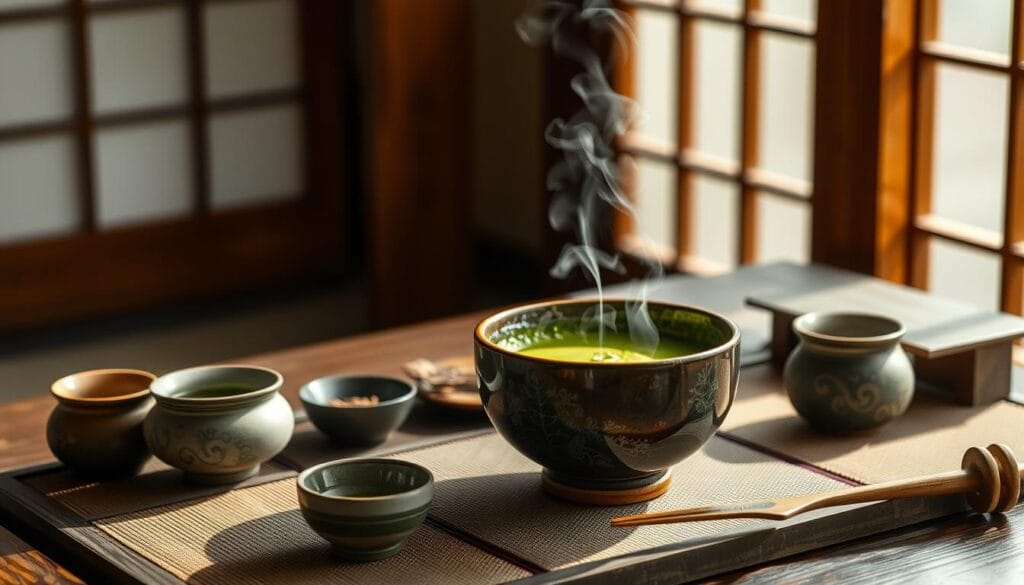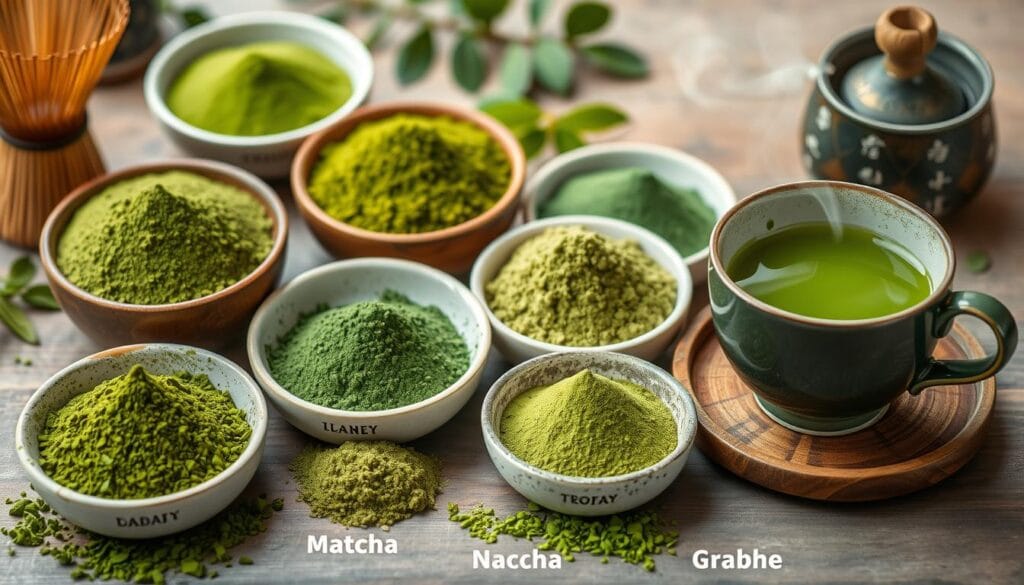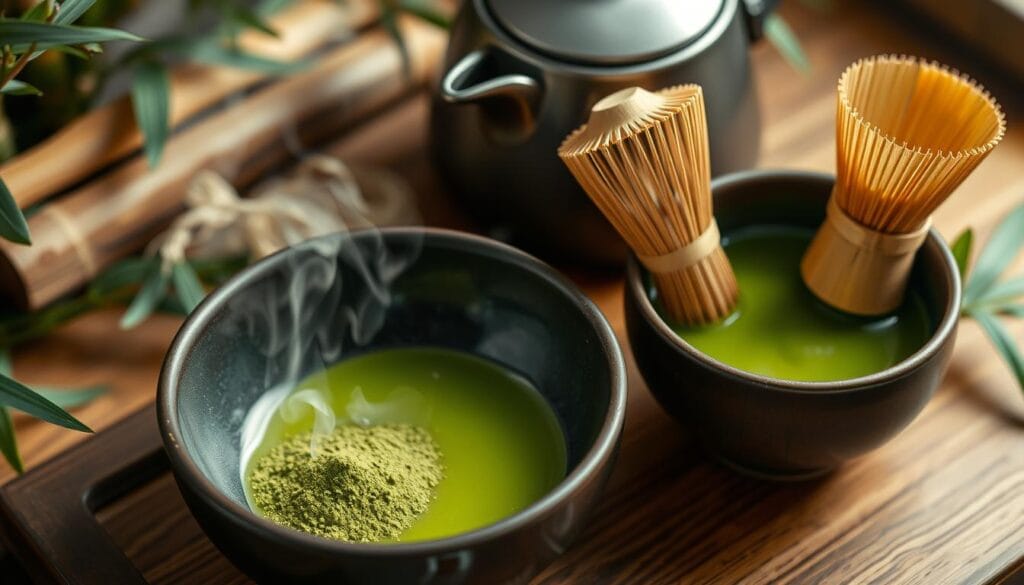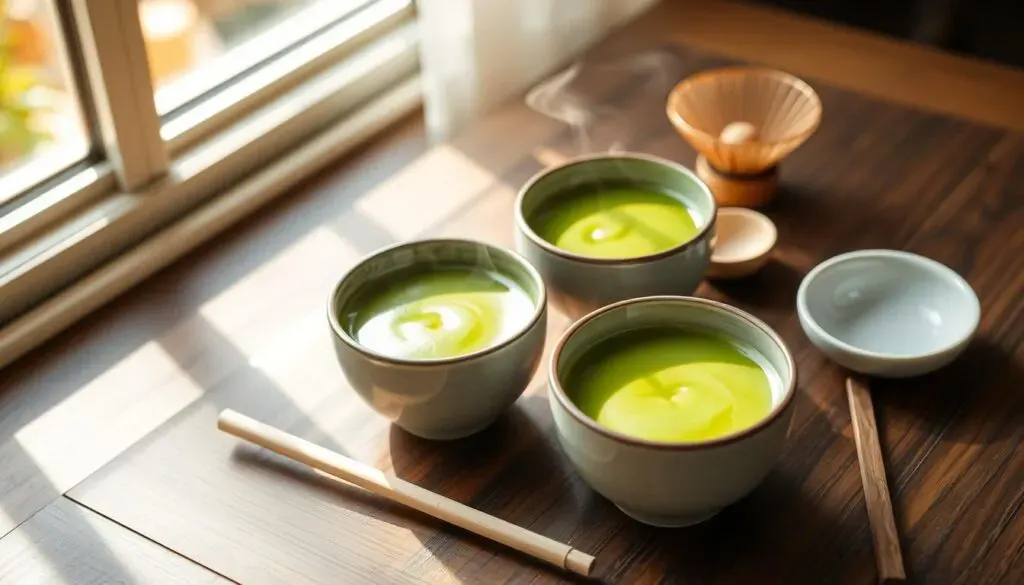Knowing the right temperature for brewing matcha is key to enjoying its full flavor and health benefits. The water’s temperature greatly affects the taste, aroma, and nutrients of this Japanese tea. Ever thought, does hot water harm matcha? The answer is yes, but only if the temperature is too high.
This article explores the art of brewing matcha, focusing on the perfect temperature. You’ll learn how to make the most of this special tea. Discover how to bring out the best in matcha by adjusting the heat.

Table of contents
- Understanding the Role of Optimal Matcha Brewing Temperature
- The Science Behind Matcha and Temperature
- Does Hot Water Destroy Matcha? Why Temperature Makes All the Difference
- Finding the Ideal Water Temperature for Matcha
- The Role of Matcha Grades in Temperature Selection
- Preparation Steps for Optimal Matcha Brewing
- Common Myths About Matcha Brewing Temperature
- Experimenting to Find Your Optimal Matcha Brewing Temperature
- Storing and Heating Water for Matcha
- FAQ
- Conclusion
Understanding the Role of Optimal Matcha Brewing Temperature
The temperature of water is very important when brewing matcha. Knowing the best water temperature for matcha is key to enjoying its full flavor and nutrients. Water that’s too hot can make the matcha taste bitter, hiding its light and delicate notes.
Controlling the temperature helps balance the matcha’s rich umami and sweetness. This balance is what makes matcha special.
Studies show that the best temperature for brewing matcha is between 160°F and 175°F. At these temperatures, you get a perfect mix of flavors. You also keep the matcha’s health benefits intact.
The Science Behind Matcha and Temperature
Understanding matcha chemistry shows how its growing methods affect flavor and health benefits. The shading before harvest boosts its antioxidants. These, like epigallocatechin gallate (EGCG), are key to its health benefits.
When making matcha, the water temperature is critical. It should be around 175°F (80°C) to keep the antioxidants intact. Higher temperatures can damage these compounds, reducing the drink’s health benefits. Matcha has up to 137 times more antioxidants than regular green tea.
Matcha fans often notice better focus, quicker reactions, and improved memory. Studies suggest it may lower the risk of brain decline and support brain health. The mix of caffeine and L-theanine in matcha gives energy without the jitters.
Matcha also helps keep cholesterol levels healthy, balancing LDL and HDL. It supports heart health by reducing inflammation, thanks to EGCG. Drinking matcha regularly, with healthy foods, boosts overall health and wellness.
Does Hot Water Destroy Matcha? Why Temperature Makes All the Difference
When making matcha, the water temperature is key. Does hot water ruin matcha? Yes, if the water is too hot, it can ruin the taste. Water that’s too hot can make matcha taste bitter and lose its natural sweetness.
Impact of Heat on Matcha’s Flavor Profile
Too much heat changes matcha’s taste. The perfect temperature brings out its rich flavors. But, boiling water can ruin this balance.
- Loss of sweetness
- Enhanced bitterness
- Reduction in complex flavors
Does matcha powder need to be dissolved in hot water? Yes, but not boiling water. Hot water is best, but it should not boil.
Effects on Nutritional Benefits
High temperatures also harm matcha’s health benefits. Antioxidants and vitamins in matcha are sensitive to heat. Boiling water can destroy these nutrients.
| Temperature Range | Flavor Profile | Nutritional Health Benefits |
|---|---|---|
| 160°F – 175°F | Sweet and umami-rich | Retains high levels of antioxidants |
| Above 175°F | Bitter and unpleasant | Reduced antioxidant capacity and health benefits |
Knowing how temperature affects matcha helps you brew the perfect cup. The right temperature lets you enjoy matcha’s unique taste and health benefits.
Finding the Ideal Water Temperature for Matcha
When brewing matcha, knowing the right water temperature is key. It affects the flavor and health benefits. The best temperature is between 160°F and 175°F. This range helps keep the matcha’s flavors and nutrients intact.
Recommended Temperature Range
Getting the temperature right is vital for a great matcha experience. Matcha from regions like Haruno in Shizuoka needs water between 160°F and 175°F. This ensures the matcha’s nutrients, like catechins and antioxidants, are released well. It also keeps the matcha smooth.
How to Achieve Perfect Temperature
To get the perfect water temperature, try these methods:
- Use a thermometer to check the water’s temperature accurately.
- Boil water and then let it cool for a few minutes until it’s in the right range.
- For a cold matcha, you can use cold water. But, it won’t have the same rich flavor as hot-brewed matcha.
Using the right techniques can make your matcha better, like with 1st harvest culinary matcha from Isagawa. It’s a high-quality matcha that offers great taste and health benefits. Paying attention to the brewing temperature is important.

The Role of Matcha Grades in Temperature Selection
Understanding matcha grade differences is key to picking the right brewing temperature. Each grade needs a specific temperature approach. This brings out the best in each matcha type.
Premium Ceremonial Matcha
Premium matcha brewing needs a gentle hand. Ceremonial grade matcha, with its bright green color and deep flavors, comes from young leaves. These leaves are shaded to boost nutrient levels, giving a rich taste that needs careful temperature control.
To keep its subtle flavors, brew ceremonial matcha at about 175°F. Using hotter water can ruin its delicate taste and reduce its health benefits.
Culinary Grade Matcha
Culinary matcha is for different uses. It has stronger flavors and can handle hotter water, making it great for lattes and baked goods. You can heat it to around 185°F without losing quality.
This flexibility makes it perfect for those who like to try matcha in many recipes.
Choosing the Right Temperature for Each Grade
Adjusting temperatures based on matcha grade improves your brewing. For premium ceremonial matcha, use lower temperatures to enjoy its complex flavors. For culinary-grade matcha, you can try slightly higher temperatures to bring out its bold taste.
By following these temperature tips, you can fully enjoy the unique qualities of both premium and culinary matcha.

Preparation Steps for Optimal Matcha Brewing
To enjoy matcha tea fully, follow key steps for brewing. These steps will help you learn how to make matcha tea well. They guide you through the process.
Pre-heating Your Equipment
Start by warming your tea bowl and whisk. This step keeps the matcha at the right temperature. Pour hot water into your bowl for a minute before brewing.
This simple step makes sure the matcha mixes well with water.
Sifting Matcha Powder for a Smooth Brew
Then, sift the matcha powder before mixing it with water. This step removes clumps that can affect the tea’s texture. A smooth matcha makes your tea more enjoyable.
Use a small sieve to make the powder airy. This way, it blends well with hot water.
Whisking Techniques for Texture
Whisking is key to a perfect matcha. Use a bamboo whisk, or chasen, and whisk in a back-and-forth motion. This adds air and makes the tea frothy and creamy.

Common Myths About Matcha Brewing Temperature
Learning about matcha can make your tea time better. Many people wonder about the right temperature for matcha. This affects its taste and health benefits.
Does Heat Ruin Matcha?
Tea lovers often ask if heat spoils matcha. Yes, hot water can change matcha’s taste. It’s important to use water at the right temperature.
Too much heat might also reduce matcha’s health benefits. Reddit users share tips to keep matcha’s flavor good. They stress the need for proper brewing.
Can You Make Matcha with Cold Water?
Using cold water for matcha is becoming popular. It offers a different taste than hot matcha. This method keeps some sweetness and is cool and refreshing.
Trying different ways to make matcha can be fun. It lets you enjoy matcha in new ways, no matter the season.
Experimenting to Find Your Optimal Matcha Brewing Temperature
Trying out different matcha temperatures can really change how you enjoy it. It lets you find the flavors and qualities that you like best. Learning how temperature affects taste and health benefits helps you perfect your brewing.
How Personal Preference Influences Taste
Your taste preferences are key in enjoying matcha. Some like hot water for a stronger taste, while others prefer cooler water for a milder drink. Finding the right temperature for you can make your matcha experience even better.
Getting feedback from others can also help. Try different temperatures with friends or family to see what they like. This can help you find the perfect matcha for you.
Adapting to Different Matcha Brands
Every matcha brand is unique, shaped by its origins and how it’s made. For example, ceremonial grade matcha needs a different temperature than culinary grade. Trying different brands can reveal new flavors and aromas.
Remember, the best temperature for matcha depends on your taste and the matcha itself.
Storing and Heating Water for Matcha
Using the right water for matcha is key to its flavor and quality. It’s important to store water well and choose the right equipment. Here are some tips on storing matcha water and making sure it’s perfect for brewing.
Best Practices for Water Storage
To keep water quality high for matcha, follow these tips:
- Use clean, filtered water to avoid contaminants.
- Store water in an airtight container to keep it fresh and flavorful.
- Don’t store water in direct sunlight, as it can change the taste.
Choosing the Right Kettle
The right kettle makes brewing matcha better. Look for these features:
- Electric kettles with temperature control are great. They heat water to the perfect brewing temperature.
- Choose kettles that keep heat well. This makes brewing better.
- Think about size and portability, if you drink matcha on the go.
| Kettle Type | Temperature Control | Brewing Time | Ideal Matcha |
|---|---|---|---|
| Electric Kettle | Yes | Quick | Premium Ceremonial Matcha |
| Stovetop Kettle | No | Moderate | Culinary Grade Matcha |
| Temperature-Control Kettle | Yes | Very Quick | Both Grades |
By following these tips, you’ll enjoy a great matcha every time. The right kettle and water storage make your tea ritual even better.
FAQ
Yes, water over 175°F can make matcha taste bitter. It loses its delicate flavors.
The best temperature for matcha is between 160°F and 175°F. This range brings out the best flavors and nutrients.
Hot water can dissolve matcha, but too hot water can lose flavor. Stick to the recommended temperature range.
Yes, you can make matcha with cold water. It tastes different, but many like it, even in warm weather.
Yes, too much heat can harm matcha’s health benefits. It also changes the taste for the worse.
Boiling water can make matcha taste bitter. It also lowers the antioxidants.
If you don’t have a thermometer, boil water and let it cool. Wait until it’s between 160°F and 175°F.
Yes, ceremonial matcha needs cooler water than culinary matcha. Culinary matcha can handle warmer water.
Conclusion
Mastering the art of making matcha is all about the water temperature. This article has given you the tools to make a great matcha. The right temperature is key to keeping matcha’s flavors and health benefits.
Whether you’re making ceremonial matcha or a latte, good brewing techniques matter. The perfect brew highlights the tea’s unique taste. It makes every moment of making tea special.
Every cup of matcha is a chance to discover its subtleties and connect with its history. Focus on the right temperature and brewing methods. This way, every sip will be full of flavor and energy.

